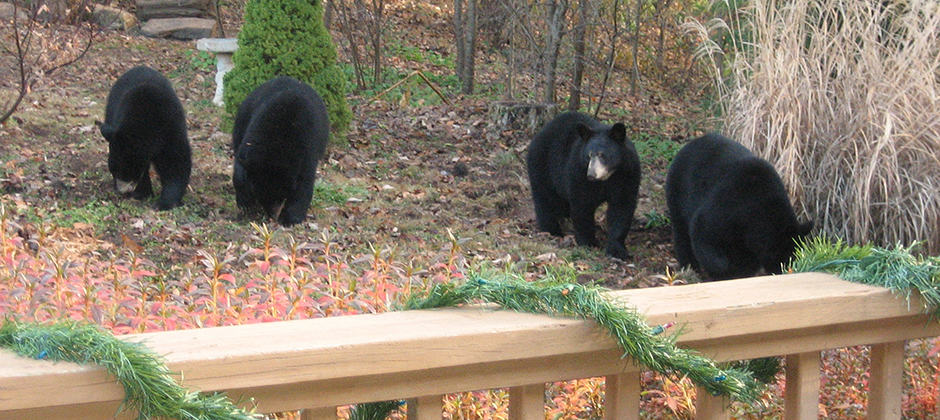Share this article
Bears in Asheville are heavier and having cubs earlier than rural bears
When North Carolina State University researchers set out to collar black bears in the city of Asheville, they noticed something unusual. Yearlings are often too small to support the weight of the GPS collars, but not these bears. Some weighed in at over 100 pounds—as much as twice the weight of many yearlings.
“We started asking, why are they so big?” said TWS member Chris DePerno, a professor of fisheries, wildlife and conservation biology at NC State.
The likely answer, the team concluded, was that these black bears (Ursus americanus), living among people within the Asheville city limits, could supplement their diet with food from human sources. Some of these bears were not only bigger. They were also giving birth earlier than bears in forested areas, with minimal exposure to people.
The researchers hypothesized that these urban bears were likely taking advantage of either soft mast foods or bulking up on Asheville residents’ garbage, outside pet food and bird feeders.
Relying on food from the city could cause negative impacts to the bear population, said DePerno, co-author on a study of these big bruins published in the Journal of Mammalogy. Being close to humans also brings an increased risk of mortality from collisions with vehicles, hunting and other sources, raising concerns that living in close proximity to people could be a population sink for bears.
“We know from other objectives of our research, if bears leave Asheville, they appear more likely to die,” DePerno said.
In a cooperative project with the North Carolina Wildlife Resource Commission, DePerno and his team, including Nick Gould, Roger Powell, Jennifer Strules and Colleen Olfenbuttel, captured black bears in the spring and summer and later visited them in their winter dens. They took measurements, assessed reproduction and compared these female bears in and around Asheville to bears in forested areas—with minimal exposure to people—in North Carolina and Virginia.
In Asheville, they noted, female yearlings were nearly double the weight of those in rural forested areas, and more than half of the two-year-old bears had given birth to cubs. That was pretty unusual. None of the rural two-year-old bears had cubs, and black bears typically do not give birth until they are three or four years old.
The research team was interested in what was causing these bears to be larger and reproducing at an earlier age. The scientists found that their observations did not track with changes in acorn and other hard mast production that the bears largely rely on. That led them to suspect that other foods, such as soft mast and anthropogenic foods, may be the most likely explanation.
“The Asheville community as a whole is pretty good at living with bears,” DePerno said, but human behavior can be hard to change. Programs like the Southeast Association of Fish and Wildlife Agencies’ BearWise educates the public about the importance of keeping garbage, birdseed and pet food away from bears, but not everybody follows the guidelines.
“With bears, it comes down to human interactions,” DePerno said. “They’re very adaptable. They can do well around people, and when people behave, they do well around bears. It is very important that people take the proper precautions and follow the BearWise principles to reduce human-bear interactions. If a bear becomes habituated to human food, it may lead to more intense interactions, which will certainly end badly for the bear.”
Now, DePerno and his team want to know if urban bear reproduction and recruitment outweigh the high mortality rates associated with urban living. If they do, it would mean the population is a source population for the surrounding areas. If not, the population is a sink.
Researchers are currently implementing methods to try to determine exactly what the bears are eating. They have also started a human dimensions survey designed to gauge public perceptions, knowledge, and attitudes toward BearWise recommendations.
“We have a lot of solid data, which naturally enables us to attempt to answer many of our questions,” DePerno said.
Header Image: Black bears have become a common sight in Asheville, North Carolina. Credit: G. Kriezel








